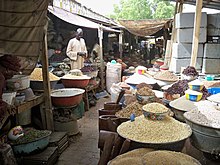Petit Marché (Niamey)
The Petit Marché , also Habou-Ganda , is a market in Niamey in Niger .
Location and characteristics
The market is located by Niamey City Hall in the Maourey district of the Niamey II arrondissement . The French name Petit Marché means "small market". Its name in Zarma is Habou-Ganda, which means "lower market". This makes the Petit Marché the counterpart to the Grand Marché (“large market”) in Niamey, which is called Habou-Béné (“upper market”) in Zarma.
Architecturally, the Petit Marché was designed as a hybrid between the modern Grand Marché and the more traditional Marché de Katako . Cement stores were built for luxury goods, while grocers set up in sheds and along the main paths, or mobile stores opted for roaming the market area in search of customers.
history
The Petit Marché was founded in 1929 under French colonial administration and is considered the oldest market in Niamey. In the 1950s a mixed population of Lebanese traders and Hausa and Fulbe had settled around the market . The market was also called Marché de huit heures (“eight o'clock market”), as it was customary for a long time that it closed at eight in the morning and the traders continued to move to the Grand Marché, which was open until the evening hours .
In 1996 the Petit Marché was renovated. A fire in 2012 destroyed the site in its previous form. The market activity then shifted to an area west of the original square, where minimum standards of hygiene and safety could no longer be guaranteed.
Product range
The specialty of the market is the sale of fruits and vegetables. These come from growing areas both in the suburbs of Niamey and in the wider area, for example from Torodi in the west of the city and from regions along the Niger River , upstream to Tillabéri and downstream to Gaya . The Petit Marché is particularly important for fruit and vegetable wholesalers. Other everyday products are also sold.
literature
- Haoua Issiaka: Le Commerce informel féminin: exemple des commerçantes du petit marché de Niamey, Niger . In: Etudes sahéliennes . No. 6 , October 2012, p. 27-46 .
Web links
- Benjamin Michelon, Laurence Wilhelm, Ibrahima Goumey: Diagnostic de l'armature commerciale de la ville de Niamey. Final report. Groupe Huit, March 2015 (PDF, French).
Individual evidence
- ^ A b Hassoumi Djibo: Etude de commercialization de la filière légumes dans la ville de Niamey . In: International Journal of Innovation and Applied Studies . Vol. 8, No. 4 , October 2014, ISSN 2028-9324 , p. 1439–1440 ( issr-journals.org [PDF; accessed March 5, 2017]).
- ↑ Hadiara Yaye Saidou: Se déplacer à Niamey, mobilité et dynamique urbaine . Thesis. Université Grenoble Alpes, Grenoble 2014, p. 86 ( tel.archives-ouvertes.fr [PDF; accessed on March 5, 2017]).
- ^ Klaas van Walraven: The Yearning for Relief. A History of the Sawaba Movement in Niger . Brill, Leiden 2013, ISBN 978-90-04-24574-7 , pp. 126 .
- ^ Benjamin Michelon, Laurence Wilhelm, Ibrahima Goumey: Diagnostic de l'armature commerciale de la ville de Niamey. Final report. (PDF) Groupe Huit, March 2015, p. 12 , accessed on March 5, 2017 (French).
- ^ Benjamin Michelon, Laurence Wilhelm, Ibrahima Goumey: Diagnostic de l'armature commerciale de la ville de Niamey. Final report. (PDF) Groupe Huit, March 2015, pp. 25 and 27 , accessed on March 5, 2017 (French).
- ^ Benjamin Michelon, Laurence Wilhelm, Ibrahima Goumey: Diagnostic de l'armature commerciale de la ville de Niamey. Final report. (PDF) Groupe Huit, March 2015, pp. 19 and 36 , accessed on March 5, 2017 (French).
- ↑ a b Présentation de la Commune Niamey II. Commune Niamey II, October 23, 2010, accessed on March 5, 2017 (French).
- ^ Benjamin Michelon, Laurence Wilhelm, Ibrahima Goumey: Diagnostic de l'armature commerciale de la ville de Niamey. Final report. (PDF) Groupe Huit, March 2015, pp. 50–51 , accessed on March 5, 2017 (French).
Coordinates: 13 ° 30 ′ 50.3 " N , 2 ° 6 ′ 37.2" E

